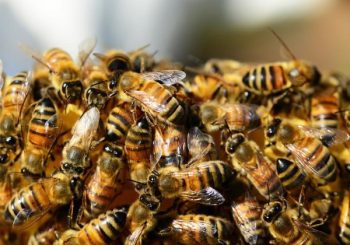By Nikki Harper
Contributing Writer for Wake Up World
It has been more than twenty years since the first alarming reports of declining bee numbers began to surface, and thirteen years since the first incidents of colony collapse disorder were reported [1]. Statistics show that honeybee populations in the United States, for example, have declined from around 6 million hives in 1947 to 2.4 million hives in 2008, a reduction of some 60% [2].
We have had two decades in which to understand how to protect our precious bee populations – and yet, here we are in 2019 and around the world, mass bee deaths continue as pesticide use increases, toxicity increases and regulation decreases. This month, news from three different countries, Brazil, Russia and the US, highlights three different kinds of problems we’re still facing:
Mass Bee Die-offs in Russia: Ineffective Pesticide Regulation
This summer, mass bee die-offs were recorded in 24 out of Russia’s 85 regions, mostly in the central and southern area [3]. Since honey forms an important part of Russia’s economy, this is set to have financial implications, but bees are also vital for the pollination of some of Russia’s key food staples, including buckwheat.
Some at Russia’s state agricultural watchdog, Rosselkhoznadzor, are frustrated that they have had to relinquish most of their power to regulate pesticide use, and many people locally blame pesticide misuse for the bee deaths. Experts agree that unregulated pesticide use most likely plays a part in the Russian bee die-offs, although this must be seen in the context of habitat loss, disease and climate change also being contributing factors [3].
Mass Bee Die-offs in Brazil: Politically Motivated Regulation Relaxation
Meanwhile, over half a billion bees died in four of Brazil’s southern states in spring 2019, with most showing traces of Fipronil, an insecticide which is banned in the EU [4]. At this time, pesticide approvals in Brazil were up 27% over the same period last year. Coincidentally – or not – President Bolsonaro was elected on a promise to loosen agribusiness regulations and is promising further relaxations on pesticide use.
Overall, Brazil’s pesticide use has increased by 770% between 1990 and 2016, and that looks set to continue under Bolsonaro’s regime. Glyphosate, the main component in Brazil’s best-selling pesticide, is either outright banned or heavily restricted by a huge number of countries [5]. Although glyphosate is a herbicide and therefore does not directly target bees and other insects, a study has shown that it does harm the intestinal bacteria of bees, making them more vulnerable to disease [6]. Interestingly, glyphosate was due to be banned in Brazil too, but that decision was overturned late last year. [5]
Bee Decline in the US: Increased Toxicity
Despite in-theory relatively strict pesticide regulations, the United States is not immune from problems in protecting its bees. A new study released this week shows that the US agricultural environment has become 48 times more toxic to bees and other insects over the last 25 years [7]. Researchers took into account the amount of pesticides used in the US during this period, how long the pesticides persist and the level of pesticide toxicity, as well as toxins found on bees, and they determined that between 1992 and 2014, neonicotinoid pesticides accounted for 92% of the increase in toxicity.
Neonicotinoids, more commonly known as neonics, attack the central nervous system of insects. The normal method of use is to coat the plant seeds in the pesticide – in the US, almost all corn and oilseed rape seeds are coated this way, as are most soybean and cotton plants and many household yard plant seeds [8].
Because the seed is coated, the pesticide becomes systemic within the plant, present in every part of it from its root and leaves to its nectar; this means it persists within the environment for longer and has potential for harm to a wider range of creatures. Anecdotal evidence from beekeepers suggests that dust from the seeds during the planting process can blow into neighboring fields and trees, thus poisoning even bees which would not have ordinarily visited the treated plants [9].
According to Bayer’s director of Pollinator Safety, David Fischer, neonics “are typically applied in a way that limits exposure to honeybees and other non-targets” [10], although the study’s results seem to refute that assertion [7]. “Neonics are like a new DDT, except they are a thousand times more toxic to bees than DDT was,” says report co-author Kendra Klein, a senior staff scientist at Friends of the Earth US [10].
Presumably Fischer is referring to the fact that the pesticide is applied to the seed not to the grown plant, but this begs the question of how harmful the chemicals may be to soil-dwelling insects. Answer: we simply don’t know [10]. What we do know is that neonics which wash out from the soil are damaging other ecosystems [11].
But back to bees. The authors assume that their estimates on bee toxicity are likely to be lower than the real situation, because they did not study the non-lethal impact of neonics on bees, such as impaired navigation, reproduction difficulties and weakened immune systems [7]. Neonics were banned in the EU in 2018 specifically because of their threat to bees [12]. In May, in the US, the EPA did ban twelve types of neonic products, but not neonics themselves, so progress here appears to be slower than necessary.
Whether it’s increased toxicity, inefficient regulatory powers or politically motivated regulation loosening, the threat to the world’s bees is clearly not over. While combatting bee disease and climate change are long term goals, the regulation of harmful pesticides is something you might think we really should be better at. As Arnold Butov, head of Russia’s Beekeepers Union puts it, “If we lose the bees, everything will be affected. We have to protect them as if they are holy”. [3]
Article sources:
- [1] http://npic.orst.edu/envir/ccd.html
- [2] https://www.greenpeace.org/usa/bees-in-decline/
- [3] https://www.themoscowtimes.com/2019/07/26/what-killing-russia-honey-bees-a66563
- [4] https://www.bloomberg.com/news/articles/2019-08-19/bees-are-dropping-dead-in-brazil-and-sending-a-message-to-humans
- [5] https://www.baumhedlundlaw.com/toxic-tort-law/monsanto-roundup-lawsuit/where-is-glyphosate-banned/
- [6] https://www.pnas.org/content/115/41/10305
- [7] https://journals.plos.org/plosone/article?id=10.1371/journal.pone.0220029
- [8] https://www.nationalgeographic.com/environment/2019/08/insect-apocalypse-under-way-toxic-pesticides-agriculture/
- [9] https://www.theguardian.com/environment/2019/aug/06/us-pesticide-neonics-toxic-harmful-bees-study
- [10] https://www.npr.org/sections/thesalt/2019/08/06/747646197/new-evidence-shows-popular-pesticides-could-cause-unintended-harm-to-insects?t=1566676645737
- [11] https://www.cbc.ca/news/canada/saskatchewan/pesticide-contaminating-prairie-wetlands-scientist-1.2482082
- [12] https://www.pan-europe.info/press-releases/2018/04/neonicotinoids-historic-day-european-union
About the author:
Nikki Harper is a spiritualist writer, astrologer, and current editor for Wake Up World.

If you've ever found value in our articles, we'd greatly appreciate your support by purchasing Mindful Meditation Techniques for Kids - A Practical Guide for Adults to Empower Kids with the Gift of Inner Peace and Resilience for Life.
In the spirit of mindfulness, we encourage you to choose the paperback version. Delve into its pages away from screen glare and notifications, allowing yourself to fully immerse in the transformative practices within. The physical book enriches the learning process and serves as a tangible commitment to mindfulness, easily shared among family and friends.
Over the past few years, Wake Up World has faced significant online censorship, impacting our financial ability to stay online. Instead of soliciting donations, we're exploring win-win solutions with our readers to remain financially viable. Moving into book publishing, we hope to secure ongoing funds to continue our mission. With over 8,500 articles published in the past 13 years, we are committed to keeping our content free and accessible to everyone, without resorting to a paywall.







